Galiteuthis pacifica
Henk-Jan Hoving, Stephanie Bush, Richard E. Young, and Katharina M. Mangold (1922-2003)Introduction
Galiteuthis pacificus is a poorly known species that has never been fully described although broadly distributed in the tropical Indo-Pacific. Males reach, at least, a length of 333 mm ML.
Brief diagnosis:
A Galiteuthis ...
- with a nearly square-shaped distal ocular photophore.
- without tubercules at the funnel-mantle fusion.
Characteristics
- Arms
- Arm suckers with smooth rings.
- Adult males with distal half of arms I and II with greatly enlarged suckers with tiny aperatures.
- Tentacles.
- Tentacular clubs: Similar to other Galiteuthis with two series of hooks and no suckers on manus, short dactylus, and well defined carpal cluster.
- Tentacles of mature males: Absent.
 Click on an image to view larger version & data in a new window
Click on an image to view larger version & data in a new window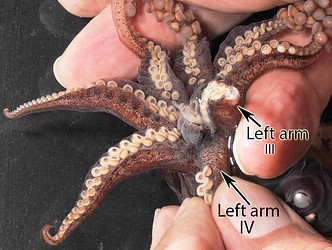
Figure. Oral view of the arm crown of the mature male of G. pacifica, 333 mm ML, showing little trace of tentacles between arms III and IV. Note the broad protective membranes on the proximal half of the arms and their wide trabeculae. Photograph by Henk-Jan Hoving.
- Tentacular clubs: Similar to other Galiteuthis with two series of hooks and no suckers on manus, short dactylus, and well defined carpal cluster.
- Head
- Beaks: Descriptions can be found here: Lower beak; upper beak.
- Beaks: Descriptions can be found here: Lower beak; upper beak.
- Photophores
- Lateral (near lens) ocular photophore very short, nearly square.
 Click on an image to view larger version & data in a new window
Click on an image to view larger version & data in a new window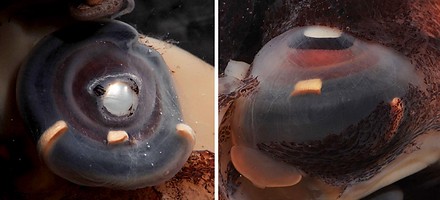
Figure. Eyes of G. pacifica, mature male, 333 mm ML. Left - Lateral view of the right eye. Right - Ventral view of the left eye. Note the U-shaped medial photophore and the near-square shape of the lateral (= distal) photophore. Photograph by Henk-Jan Hoving.
- Lateral (near lens) ocular photophore very short, nearly square.
- Mantle-funnel fusion: Tubercules absent.
- Viscera
- Overview: The mature male with the mantle cut open shows surprisingly sparse viscera.
- Male reproductive structures: The terminal organ seems to contain a single spermatophore and no testis was obvious. Possibly the squid was a spent male.
- Overview: The mature male with the mantle cut open shows surprisingly sparse viscera.
Life History
Paralarva/juvenile:



Figure. G. pacifica. Left - Dorsal and ventral views of a paralarva of 4.8 mm GL, Hawaiian waters. Note characteristic elongate mantle chromatophores. Bar - 1 mm. Drawings by R. Young. Right - Ventral view of a juvenils, 42 mm ML, eastern Pacific. Drawing from Young (1972).
Adult male:

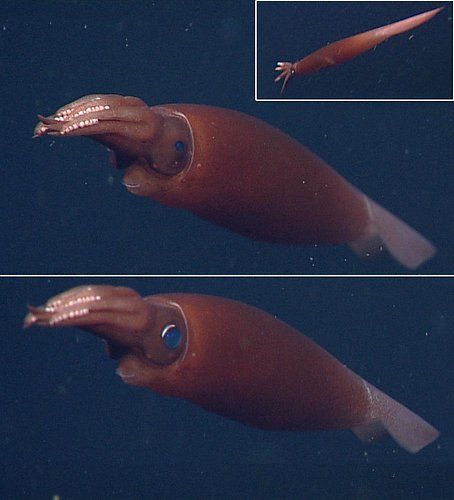
Figure. Lateral and anterolateral views of an adult male G. pacifica. In situ photographs from an MBARI ROV taken at 2307 m, Gulf of California. In the larger images, note the different stages of contraction of the eyelid which seems to involve a simple circular contraction. The time difference from the open eyelid to the nearly closed eyelid was about 2 sec. Also note the very large suckers on the arms and the absence of tentacles. © 2013 MBARI.
Distribution
Geographical distribution
Type locality - off Cocos Island, eastern tropical Pacific.
A tropical Indo-Pacific species known from the western Indian Ocean to New Caledonia, Southern California, Panama and northern Chile (Nesis, 1982). In the Pacific its range extends north to 28°N in the central Pacific, 34°N in the California Current, and south to 30°N in the Peru-Chile current (Voss et al., 1992).
Vertical distribution
A study of the vertical distribution in Hawaiian waters (chart below) found most captures of squid greater than 20 mm GL in size came from depths of 700 m or more. This species does not appear to undergo diel vertical migration.

Figure. Vertical distribution chart of G. pacifica, modified from Young, 1978. Captures were made with both open and opening/closing trawls. Bars - Fishing depth-range of opening/closing trawl. Circle - Modal fishing depth for either trawl. Blue-filled circles - Night captures. Yellow-filled circles - Day captures.
References
Nesis, K. N. 1982/87. Abridged key to the cephalopod mollusks of the world's ocean. 385+ii pp. Light and Food Industry Publishing House, Moscow. (In Russian.). Translated into English by B. S. Levitov, ed. by L. A. Burgess (1987), Cephalopods of the world. T. F. H. Publications, Neptune City, NJ, 351pp.
Voss, N. A., S. J. Stephen and Zh. Dong. 1992. Family Cranchiidae. p. 187–210. In: Sweeney, M. J., C. F. E. Roper, K. M. Mangold, M. R. Clarke and S. V. Boletzky (eds.). "Larval" and juvenile cephalopods: a manual for their identification. Smithson. Contr. Zool., No. 513: 1-282.
Young, R. E. 1972. The systematics and areal distribution of pelagic cephalopods from the seas off Southern California. Smithson. Contr. Zool., 97: 1-159.
Young, R. E. 1978. Vertical distribution and photosensitive vesicles of pelagic cephalopods from Hawaiian waters. Fish. Bull., 76: 583-615.
Title Illustrations

| Scientific Name | Galiteuthis pacifica |
|---|---|
| Location | Gulf of California at 24.37°N, 109.21°W |
| Comments | In situ photograph of G. pacifica taken at a depth of 1324 m. Squid not captured but note the diagnostic shape of the distal ocular photophore. |
| Acknowledgements | Image courtesy of the Monterey Bay Aquarium Research Institute (MBARI). You must obtain permission from MBARI to use this photo; please contact pressroom@mbari.org for further information |
| Specimen Condition | Live Specimen |
| Identified By | R. E. Young |
| Life Cycle Stage | Subadult |
| View | Side |
| Size | Unknown |
| Copyright | © 2013 MBARI |
About This Page

GEOMAR-Helmholtz Centre for Ocean Research Kiel

Monterey Bay Aquarium Research Institute

University of Hawaii, Honolulu, HI, USA
Katharina M. Mangold (1922-2003)

Laboratoire Arago, Banyuls-Sur-Mer, France
Page copyright © 2016 , , , and Katharina M. Mangold (1922-2003)
 Page: Tree of Life
Galiteuthis pacifica .
Authored by
Henk-Jan Hoving, Stephanie Bush, Richard E. Young, and Katharina M. Mangold (1922-2003).
The TEXT of this page is licensed under the
Creative Commons Attribution-NonCommercial License - Version 3.0. Note that images and other media
featured on this page are each governed by their own license, and they may or may not be available
for reuse. Click on an image or a media link to access the media data window, which provides the
relevant licensing information. For the general terms and conditions of ToL material reuse and
redistribution, please see the Tree of Life Copyright
Policies.
Page: Tree of Life
Galiteuthis pacifica .
Authored by
Henk-Jan Hoving, Stephanie Bush, Richard E. Young, and Katharina M. Mangold (1922-2003).
The TEXT of this page is licensed under the
Creative Commons Attribution-NonCommercial License - Version 3.0. Note that images and other media
featured on this page are each governed by their own license, and they may or may not be available
for reuse. Click on an image or a media link to access the media data window, which provides the
relevant licensing information. For the general terms and conditions of ToL material reuse and
redistribution, please see the Tree of Life Copyright
Policies.
- Content changed 29 August 2016
Citing this page:
Hoving, Henk-Jan, Stephanie Bush, Richard E. Young, and Katharina M. Mangold (1922-2003). 2016. Galiteuthis pacifica . Version 29 August 2016 (under construction). http://tolweb.org/Galiteuthis_pacifica/19573/2016.08.29 in The Tree of Life Web Project, http://tolweb.org/




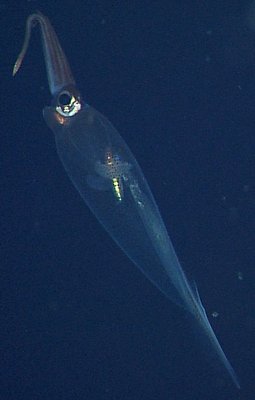
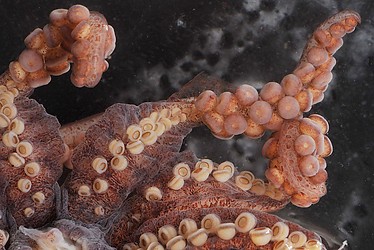







 Go to quick links
Go to quick search
Go to navigation for this section of the ToL site
Go to detailed links for the ToL site
Go to quick links
Go to quick search
Go to navigation for this section of the ToL site
Go to detailed links for the ToL site